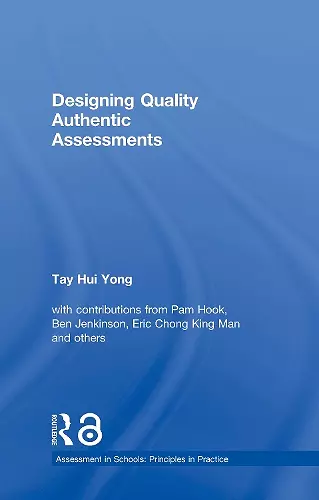Designing Quality Authentic Assessments
Format:Hardback
Publisher:Taylor & Francis Ltd
Published:27th Apr '18
Currently unavailable, and unfortunately no date known when it will be back
This hardback is available in another edition too:
- Paperback£36.99(9781138896529)

This book examines the principles and practice of authentic assessment. It seeks to answer the following questions. What is authentic assessment? How is authentic assessment different from 'performance assessment' or 'alternative assessment'? How can authentic assessment support learner-centred education, especially when a performance-oriented culture favours pen-and-paper examinations?
The book is structured into two major parts. The first, 'Principles of authentic assessment design', provides readers with a conceptual explanation of authenticity; the principles for designing quality authentic assessments for valid evidence of student learning; and guidance about how to develop quality rubrics to structure assessment tasks.
The second part of the book, 'Theory into practice' provides examples developed by teachers to demonstrate an understanding of authentic assessment. The subject areas covered include humanities, languages, mathematics, sciences, character and citizenship. Two case studies are discussed to demonstrate how authentic assessment can be used to comprehensively address key learning objectives in a variety of curriculum contexts.
This book provides practitioners with concrete examples on how to develop authentic assessment to suit their context and also enhance their students’ learning. The book will also enable teachers to face assessment challenges present in our changing world.
Chapter 1 of this book is freely available as a downloadable Open Access PDF under a Creative Commons Attribution-Non Commercial-No Derivatives 4.0 license available at http://www.taylorfrancis.com
'Authentic assessment is assessment that mirrors what it is in the real world we want students to learn. We want students to enact performances that show they have understood and can use what we have taught them at an acceptable level. Just telling us back what we have taught them – typical assessment practice fr a long time – just doesn’t cut it. The practical issues are: to make clear what outcomes we want students to achieve, to design tasks that mirror those outcomes, and to be able to judge what an acceptable level of performance or of understanding is. Thus book is in two parts: the principles of authentic assessment design and their application to a wide range of school subjects.
This is an important work for without properly designed authentic assessment we cannot be really sure if we have successfully taught what we wanted students to learn. And what could be more important than that to a teacher? One of the critical aspects of this form of assessment is designing rubrics or criteria for judging quality of performance: this is handled by Pam Hook using her well known work on the SOLO Taxonomy. Tay Hui Yong and her team are to be congratulated in making the principles so clear and the applications to so many subjects so available to teachers.' - John Biggs, Honorary Professor of Psychology, University of Hong Kong, Hong Kong
ISBN: 9781138896505
Dimensions: unknown
Weight: 453g
232 pages